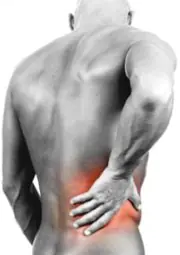Let's consider the structure of the human spine: between the vertebrae there are peculiar pads - intervertebral discs, which are based on cartilage. These discs are designed to ensure that body vibrations during movement (jumping, running, walking) are softer and smoother and have the least negative impact, in other words, they perform the role of shock absorber.
This effect is achieved due to their structure: each intervertebral disc includes a fibrous ring, inside of which there is a nucleus pulposus. Under pressure, the ring does not allow the fluid of the gelatinous body to flow out, thereby maintaining the necessary pressure inside, which ensures the shock-absorbing effect of the disc as a whole.
When an intervertebral hernia occurs, a pathology occurs in the integrity of the fibrous ring, which limits the fluid core. The lumbar part of the spine is most susceptible to this disease, since it is this section that bears the maximum load. And when doing fitness, bodybuilding, powerlifting or weightlifting this load on intervertebral discs increases exponentially!!! Exercises that involve lifting weights from the floor, such as deadlifts, bent-over rows, and squats, are especially unfavorable and dangerous.
I would like to note that the main cause of intervertebral hernias, with the exception of those acquired through irrational training with weights, unfortunately, is heredity. The result of this is a pathology that causes degeneration of connective tissues and, as a consequence, poor blood supply to the fibrous rings. Under heavy load, such a ring simply cannot withstand the pressure and its wall breaks. The consequence of this is an intervertebral hernia. In this case, the nucleus pulposus completely or partially comes out. This action causes pain and limited movement.
When treating this diagnosis, medications are used that provide pain relief and serve as an anti-inflammatory agent (glucosamine and chondroitin). In completely advanced or complex cases, you will have to resort to surgical intervention.
Unfortunately, intervertebral hernia is a disease that precludes intense physical training. However, you shouldn’t completely abandon them. You just need to follow a few rules that will significantly minimize the risk of complications of this disease:
- Do not perform any exercises without advice from a specialist: a surgeon, traumatologist, sports orthopedist.
- Under no circumstances should you borrow during an exacerbation of the disease.
- Before the main workout, a high-quality warm-up is strictly necessary to warm up the muscles and improve blood circulation.
- Exclude from the set of exercises those that can lead to the progression of intervertebral hernia. You can analyze your loads and replace one type of training with another. For example, you can do leg presses (the load should be light) instead of squats with weights.



